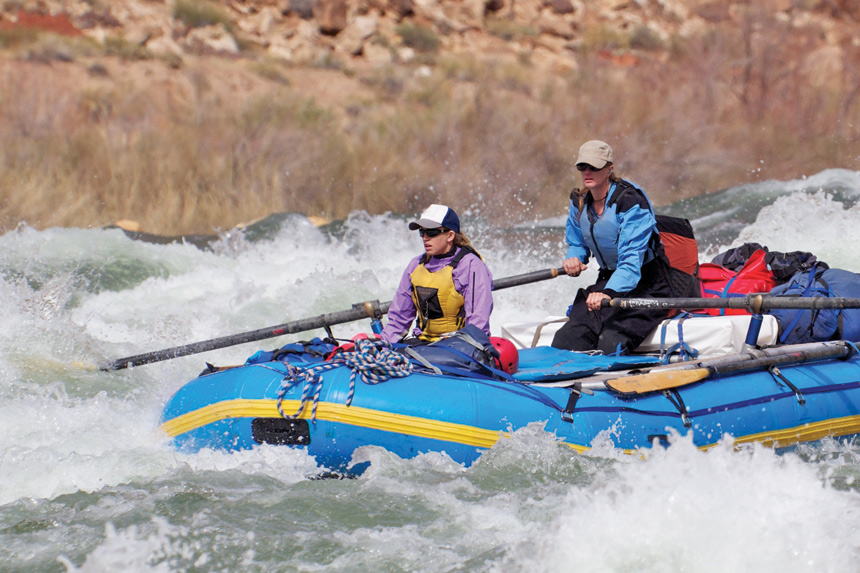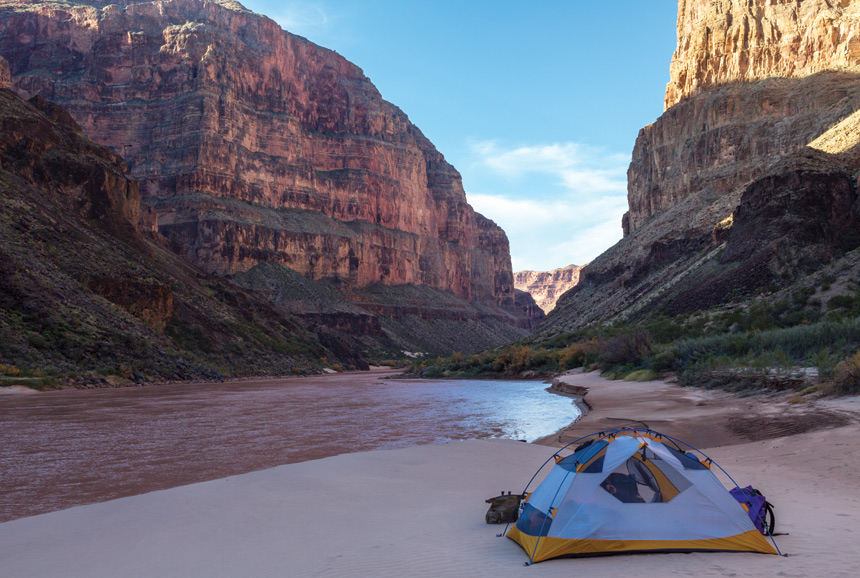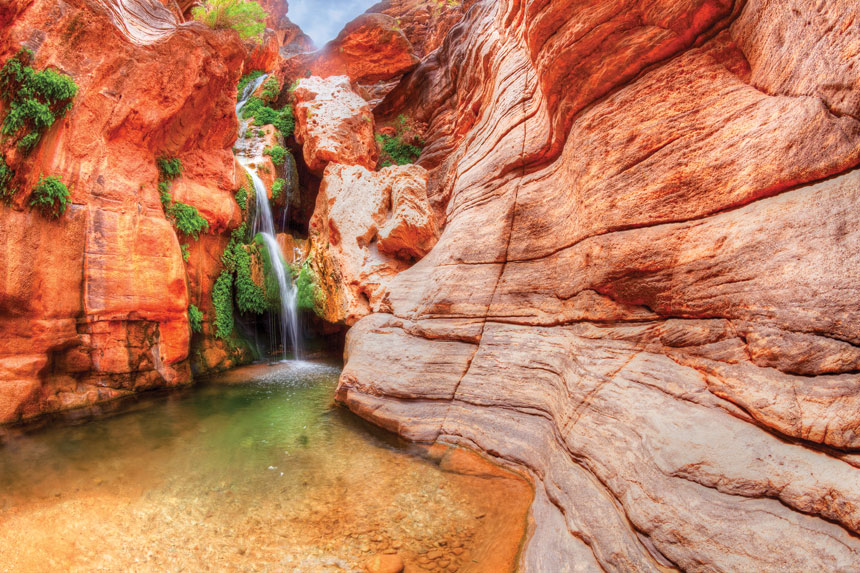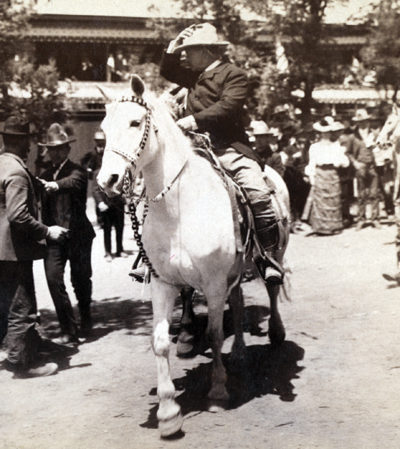Rafting the Colorado
Bang! The sound was explosive, like a gunshot. I woke from a deep sleep and looked around, frightened. Nothing, except bodies curled up in sleeping bags around our campsite on the Colorado River in the Grand Canyon. Bang! On a ledge just six feet above me, two bighorn rams collided head-on, butting horns during the rut. I reached for my camera, but the movement startled them, and they darted away.
I looked up at the billion-year-old red cliff walls of the canyon rising thousands of feet into the sky. It was first light, and the cliffs were blanketed in pink and lavender. By noon, they’d turn plum and russet, and in late afternoon, a vermilion curtain would form on the walls. When the sun dipped, they glowed burnished copper, and at night in the moonlight, they turned silver. Here on the river, it was warm enough not to need a tent, and I would lie awake for hours mesmerized by the universe of stars sparkling like cluster bombs.

Bang! Were the bighorns back? No, it was the food locker slamming shut as a guide prepared breakfast. At the edge of the river, three large yellow rubber rafts and a wooden supply boat were tied up to the tamarisk trees. Paddles and life preservers lay in neat piles on the sand. Bacon sizzled in a cast iron pot, and the smell wafted into the air as the 17 other members of my two-week paddling expedition began to stir.
I’d come on this trip because, a few years before, I’d rafted Oregon’s wild Rogue River and loved the rapids. “If you like them big,” my guide had said, “then you need to raft the Colorado.”
The Colorado River is a gauntlet of 161 rapids, but there are also long stretches of still water when you have the time to see how the river has cut through and down to the depth of a mile, exposing rock strata with layers dating back to Precambrian times and creating the 277-mile-long Grand Canyon. In the calm stretches, our guide, Martha Clark, would regale the six of us with stories about the Canyon’s earliest river runners.
In the summer of 1869, Union officer Maj. John Wesley Powell, a professor of geology who’d lost his right arm at Shiloh, loaded up four wooden boats, hired a crew of nine, and set out on a geological expedition of the river in the Canyon. They floated through a magnificent terrain, which Powell observed from an armchair lashed into the deck so he could see farther ahead and spot the rapids. But soon, the boats began to leak, the men were bitten nonstop by mosquitoes, it either rained or was scorching hot, and the oars splintered in the roaring water.
A month into the expedition, one crewmember left, saying that he’d had enough adventure for one lifetime. Near the end of the journey, the remaining men came to a particularly menacing-looking rapid at what is now called Separation Canyon. Convinced that it was impassable, three terrified crewmembers left the expedition — and were never heard from again. Some say they were killed by members of a local Indian tribe or by Mormon settlers, but no one knows for sure. After 14 weeks, the six survivors arrived at the mouth of the Virgin River near Lake Mead. “They were the first people to have successfully run the river,” Martha announced, and in a show of appreciation for Powell, we pulled our paddles out of the water, stuck them high into the air, and banged the blades together.
As we paddled along, day after day, I often found myself looking around in awe. Six million years ago, a river formed and began to cut through a canyon until it became as deep as it is today. The layers of rock contain the past lives of millions of animals and plants, from one-celled creatures to trees hundreds of feet tall. It’s one of the few places where you can see, touch, hike, and raft through the story of Planet Earth.
I never tired of the cliffs. Sometimes they looked like ancient stone faces, and other times like chiseled snakes or lions; they were always changing, mystifying, magical. They also seemed to say, “Slow down. Take it all in.” And we didn’t just watch from the water. One day we hiked up to the Nankoweap Granaries, a row of square windows cut into the sandstone around A.D. 1100. Hunters and gatherers had raised crops and lived there for thousands of years before the Spanish discovered the canyon.

In the 1500s, the first foreigners to see the Grand Canyon were Francisco Vasquez de Coronado and his men. They were looking for a great river rumored to reach from the Gulf of California to the interior of the New World, where the fabled cities of Cibola, rumored to hold great wealth, were said to be located. Coronado’s search party found the canyon but reported that it was completely uncrossable, so Coronado and his explorers left for Mexico.
In 1896, George F. Flavell, a trapper who ran the river, wrote in his journal, “There is only one stone we must not hit: our Tomb Stone.” He made it all the way, even arriving with a few beaver pelts. Another trapper, Nathaniel T. Galloway, succeeded and figured out a safer way to run the rapids: by turning the boat around so the rower faced forward with the stern ahead. This made it possible for rowers to see where they were going and be able to maneuver the boats around whirlpools and rocks. Since then, many have used this technique.
In 1903, President Theodore Roosevelt visited the Grand Canyon and was so impressed with its beauty that in 1908, he declared it a national monument. On February 26, 1919, it became Grand Canyon National Park, and 37,745 people visited. This year, the park celebrates its 100th anniversary. Last year, 6,254,238 people visited to stand at the rim, do a day hike, or run the river.

While hiking portions of the park or standing mesmerized above it is almost a religious experience, for me the greatest thrill is running the rapids. Each one has a name: Crystal and ABC (Alive Below Crystal), Lava Falls, Hermit, Hance, and House Rock. And each one comes with its own adrenalin-pumping challenge — house-sized boulders, roller-coaster waves, or garage-wide wedge holes, enough to toss all passengers and gear overboard.
I didn’t know if we’d capsize, but we followed Martha’s simple commands: forward paddle, back paddle, left side, right side. “High side!” meant we were about to encounter a huge wave and needed to scramble to the side that was being lifted up by the water to stop ourselves from “swimming.”
We’d hear the rapids long before we saw them. One day, in the distance, there was a roar like a huge truck thundering down a gravel road. But of course there were no roads; it was the sound of an upcoming rapid. As we approached, the noise became ear-piercing. We braced our legs tight against the gunwales in preparation, hearts pounding.
Then, without warning, our little yellow raft shot through icy gray waves that splashed up over the gunwales, hitting us in the face. “Back paddle! Back paddle!” Martha screamed, and we reversed blindly as hard as we could. For a moment, our raft bobbed helplessly like a rubber duck in a Jacuzzi. Then, “Forward paddle!” and we roller coastered through a new set of waves until we finally hit smooth water and banged our paddles together victoriously in the air.

Some days were quiet, and we tied up the boats and hiked to magical side canyons. In one of these, known as Silver Grotto, we pulled ourselves up by a hanging rope and walked among placid sunken pools. At Vasey’s Paradise Falls, we ran shrieking with delight through a frigid waterfall, then scrambled up rocks and dared each other to jump into the river. And there were also times we were silent, like at Elves Chasm, a magical grotto where we sat in a cave listening to the sound of droplets of water as they softly splashed onto the sandstone.
Each afternoon we’d pull into a campsite, choose a sandy spot for our sleeping bags, wash the silt off our bodies in the river, and change into dry clothes for dinner. After, we’d sit around the campfire and the guides would share stories about the river. There have been deaths, especially to passengers who didn’t wear life jackets. And there were plenty of inspiring quotations to pass along. In 1937, an Idaho gas station attendant, Haldane “Buzz” Holmstrom, was the first to run the river alone. In his log he wrote, “Some people have said I conquered the Colorado River — I don’t say so. It has never been conquered and never will. Anyone who it allows to go through its canyons and see its wonders should feel thankful and privileged.”
The layers of rock contain the past lives of millions of animals and plants … one of the few places where you can see, touch, hike, and raft through the story of Planet Earth.
That’s exactly how I felt, awed by the scenery, the solitude, the lush side canyons, floating down the river, and the stories of the early river runners. My favorite was Georgie White Clark — no relation to our guide, Martha Clark. Prior to Georgie, women had been allowed to run the river only as passengers. But stubborn and audacious Georgie, who loved white water, lashed three enormous sausage-shaped bridge pontoons together, added a motor, hired a crew of firefighters, and in the 1950s, pioneered the first large-scale commercial Colorado River trips. She was both the first female river outfitter and the longest-running river guide. She captained her rig wearing a leopard-print bikini with its own tail. Each afternoon, she pulled her huge boat into a campsite and whipped up a pitcher of “Stupid” (Kool-Aid laced with grain alcohol) for her customers.
In the spring of 1983, the Colorado River experienced a runoff of a size and intensity not witnessed in generations. All river expeditions were canceled except those already in progress. Four motor rigs were destroyed, a dozen oar boats flipped, one person died, and 91 people had to be evacuated by helicopter. Georgie rowed her boat into Crystal, the gnarliest rapid of all, and although she made it through with no problem, all of her passengers “swam.” Fortunately, no one was injured. When a guide asked Georgie what happened, she answered, “I told ’em to hang on. They don’t make passengers like they used to.”

During the same time, river guide Kenton Grua and two other expert oarsmen set out to race the 277 miles of the Colorado as fast as possible to achieve a speed record aboard his wooden dory, The Emerald Mile. He had no warning there’d been a spill-off and that he’d be rowing through the most extreme conditions imaginable. In spite of injuries to his rowers and the boat, the threesome completed the trip in 36 hours, 38 minutes, and 29 seconds. Grua’s record stood until 2016, when a team of kayakers made the trip in 35 hours and 5 minutes, a record broken just two days later by a solo kayaker who did it in 34 hours and 2 minutes.
But why would anyone want to speed through one of the most majestic places on Earth? And now, on the Grand Canyon’s 100th anniversary, I worry about our greatest American wonder. The Grand Canyon is presently under assault. Helicopter tours, once forbidden, are destroying the silence. ATVs tear along the North Rim. An Italian company is trying to push through a massive South Rim development whose water demands will compromise many of the canyon’s magical springs. There is talk of building a huge tramway to the bottom of the canyon, complete with a restaurant and resort, at the confluence of the Little Colorado and the Colorado, a spot considered by the Native Americans to be the most sacred. And the administration is considering uranium mining on a million acres adjacent to the Grand Canyon.
President Theodore Roosevelt said, “The Grand Canyon is absolutely unparalleled throughout the wide world. Do nothing to mar its grandeur, sublimity, and loveliness. You cannot improve on it. But what you can do is to keep it for your children, your children’s children, and all who come after you, as the one great sight which every American should see.”
I hope, for the Grand Canyon’s 100th anniversary year and forever into the future, this remains true.
Margie Goldsmith’s last piece for the Post was “I’m Still Here” in the March/April 2018 issue.
This article is featured in the March/April 2019 issue of The Saturday Evening Post. Subscribe to the magazine for more art, inspiring stories, fiction, humor, and features from our archives.
Featured image: Shutterstock